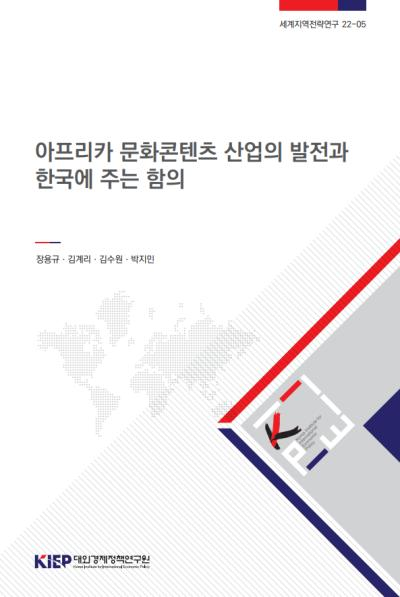Working Papers
PUBLISH
Working Papers
To list

Creative Industry in Africa from the Perspective of Korea
Economic cooperation, Industrial policy
Author Yongkyu Chang, Kye Ri Kim, Suweon Kim, and Jimmyn Parc Series 22-05 Language Korean Date 2022.12.30
Cultural and creative products are not just containers of historical and cultural identities but commercial goods tradable across borders. Simultaneously, culture is one of the primary sources of so-called “soft power,” along with political values and legitimate national foreign policy. Hence, the Korean government has been taking a leading role in building up the cultural and creative industry since the 1990s. The “Hallyu,” or craze for Korean creative products outside Korea, has been expanding across the world, from the epicenter of Asia and North America to the Middle East, Latin America and Africa. While such expansion led to interest in the mediascape of varied regions around the world, Africa has remained in the margin of academic and policy research of the creative industry. This report aims to provide information and analysis of the less studied mediascape in Africa.
Given the growing cultural engagement between Korea and the countries in Africa, this report examines the creative industry in Africa from three distinctive perspectives of development cooperation in creative industry, cultural public diplomacy and trade in cultural and creative goods. Drawing on field research and secondary research on production, retailing and consumer environment in the creative industry, this report provides lessons for further inter-continental cultural engagement.
Africa is a continent with 55 nations. Acknowledging the diversity in mediascape in each country, this report narrows its focus down to three representative countries. First, Rwanda, located in East Africa, provides an exemplary case of the media being used as a powerful political tool. The destructive role of radio during the genocide in the 1990s has been cited in explaining the danger of the media. The tragic experience resulted in strong government intervention in the creative industry. Second, Nigeria in West Africa is leading the production of films, particularly in the informal economy, which is better known as Nollywood. In the relative absence of government intervention, producers and retailers in Nollywood have built Nollywood into the world’s second largest movie producer in terms of the number of films produced. Third, South Africa reveals rather different roles of the creative industry in relation to most sub-Saharan African countries. Its creative industry is well integrated in the global value chain, and the South African government offers incentives to make its local creative industry more attractive to international producers and retailers. This policy direction is in tandem with reconciliation and development of the historically less-privileged by the post-apartheid government.
Drawing on analysis of the three countries, the report suggests as follows. First, Rwanda provides the potential of development cooperation in creative industry. The size of the formal economy in the creative industry is, like that of most African countries, too insignificant to attract stakeholders in Korea’s creative industry. However, an increasing number of African countries, including Rwanda, Tanzania, and Ghana, are recognizing the role of the creative industry in economic growth. These countries lack institutional experiences to build up the industry. Therefore, such countries will become effective destinations of Korea’s development cooperation in the creative industry, focusing on capacity-building through the sharing of Korea’s knowledge and experience. Cities are better equipped in providing hands-on experience in the creative industry. Here, the government agency in charge of development cooperation (KOICA) can take the role of a pilot agency. Upon the request of partner countries, KOICA can initiate partnering the countries in Africa and cities in Korea which have relevant experiences in varied sectors in the creative industry.
On the other hand, our research in Nigeria and South Africa offers lessons in light of public-private cooperation and private sector engagement. Nigeria reveals opportunities for public-backed private sector engagement. The government’s trade agency (KOTRA) can take a leading role in understanding Africa’s active-yet-unregulated market and provide private stakeholders with pertinent consultations. For instance, Nigeria is the largest economy in Africa with a massive pool of potential consumers for varied creative goods. Additionally, its film industry is distinctively commercial-oriented. Lastly, South Africa offers significant opportunities for stakeholders in the creative industry as a gateway country to Africa. Its creative industry is well integrated with the global value chain and its broadcasting companies and telecommunications companies are operating across Africa. Its infrastructure is relatively well-established and government regulations are in place to support international producers and retailers.
In conclusion, existing studies on Africa’s creative industry remain mere translation of studies carried out by Western researchers. This report contributes to widening the territory of our understanding of the African mediascape from Korea’s own reference point. While this report limits its scope to three representative countries, further research is necessary to understand the mediascape of Africa better.
Sales Info
| Quantity/Size | 242 |
|---|---|
| Sale Price | 10 $ |
 공공저작물 자유이용허락 표시기준 (공공누리, KOGL) 제4유형
공공저작물 자유이용허락 표시기준 (공공누리, KOGL) 제4유형
대외경제정책연구원의 본 공공저작물은 "공공누리 제4유형 : 출처표시 + 상업적 금지 + 변경금지” 조건에 따라 이용할 수 있습니다. 저작권정책 참조
